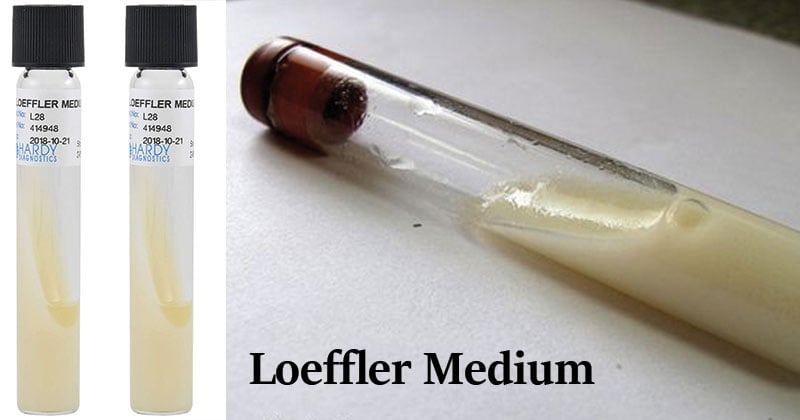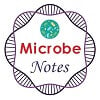Loeffler Medium is a modification of the original formula developed by Loeffler in 1887. Loeffler medium enhances primary and secondary isolation and cultivation of fastidious pathogenic microorganisms, especially from the nose and throat. It also restores virulence and other identifying properties (microscopic and colonial) after they have been lost due to prolonged incubation or repeated subculturing. The high serum content helps in determining the proteolytic activity of organisms. It is also used for the demonstration of pigmentation and ascospores.

Interesting Science Videos
Composition of Loeffler Medium
| Ingredients | Gms/liter |
| Proteose Peptone | 2.5gm |
| Dextrose | 2.5gm |
| Sodium Chloride | 1.25gm |
| Beef Extract | 2.5gm |
| Horse Serum | 750.0 ml |
Final pH (at 25°C): 7.6 +/- 0.3
Principle of Loeffler Medium
The medium contains horse serum, beef extract, dextrose, and proteose peptones which together supply the complex nitrogenous substances and nutrients necessary to support the growth of Corynebacterium diphtheriae. Sodium chloride is added to supply essential ions. Dextrose is a source of fermentable carbohydrates. The serum causes the medium to coagulate during the sterilization process and is the source of protein that is used for the metabolism of corynebacteria and other organisms. The medium enhances the development of metachromatic granules as seen in methylene blue stains. The formation of the granules demonstrates the characteristic cellular morphology of C. diphtheriae.
Preparation and Method of Use of Loeffler Medium
- Suspend 8.75 grams in 250 ml distilled water.
- Dissolve the medium completely and sterilize by autoclaving at 10 lbs pressure (115°C) for 20 minutes.
- Cool to 50-55°C and aseptically add 750 ml of sterile horse serum.
- Mix well and aseptically dispense into sterile tubes.
- Sterilize the medium by inspissation at 80-85°C for 2 hours in free-flowing steam for at least 3 consecutive days.
- Prior to inoculation, allow the medium to equilibrate to room temperature.
- Using a fishtail motion, directly inoculate specimen swab onto the medium.
- Incubate aerobically at 35ºC. for up to 4 days.
- Observe daily for typical colonial morphology of
- Perform methylene blue stain to check for the presence of metachromatic granules and appearance suggestive of Chinese-letter formation of cells.
- Definitive identification of C. diphtheriae is made by performing biochemical and toxigenicity tests.
For Detection of Proteolysis of Aerobic Microorganisms
- Inoculate medium with isolated colonies of the organism in question.
- Incubate aerobically at 35ºC for 3-4 days.
- Observe for typical colonial morphology.
For Detection of Proteolysis of Anaerobic Microorganisms
- Inoculate medium with isolated colonies of the organism in question.
- Incubate anaerobically at 35ºC. for 3-4 days or overlay the inoculated slant with Thioglycollate Broth just prior to incubation, tighten the cap and incubate aerobically.
- Observe for typical colonial morphology.
Result Interpretation on Loeffler Medium
- Growth of Corynebacterium species on Loeffler Medium appears as Corynebacterium species reveal metachromatic granules and appearance suggestive of Chinese-letter formation in methylene blue stain.
- Proteolysis is indicated by the appearance of colonies surrounded by a small crater of liquefied medium or liquefaction of the slant with the production of a putrid odor.
| Organisms | Growth |
| Corynebacterium diphtheriae | Growth; minute, and cream-colored colonies with slightly raised centers; metachromatic granules seen in methylene blue stain |
| Corynebacterium pseudodiptheriticum | Growth; minute, and cream-colored colonies |
| Pseudomonas aeruginosa | Good growth; green colonies with proteolysis |
| Staphylococcus aureus | Good growth; yellow to gold colonies |
| Streptococcus pyogenes | Fair to good growth; non-proteolytic |
Uses of Loeffler Medium
- The primary value of Loeffler medium is in the growth and morphological characterization of members of the genus Corynebacterium. This formulation enhances the formation of metachromatic granules within the cells of the organisms.
- Due to its serum content, Loeffler medium can be used for the determination of proteolytic activities of microorganisms.
- The gray-white surface of the medium provides an excellent background for the detection and observation of colonial pigmentation.
- If all extraneous moisture is removed aseptically from the slants and the upper part of the slant is heated until the slant ruptures, this medium can be used for the detection of ascospores.
Limitations of Loeffler Medium
- It is recommended that biochemical, immunological, molecular, or mass spectrometry testing be performed on colonies from pure culture for complete identification.
- It is recommended that selective and non-selective media be inoculated in parallel to Loeffler Medium for isolating C. diphtheriae; Potassium Tellurite Cystine Agar and Blood Agar are recommended for enhanced recovery.
- To optimize recovery of C. diphtheriae, a nasopharyngeal and throat specimen should be obtained upon specimen collection.
- Variation in microscopic morphology may vary from lot to a lot of Loeffler Medium.
- Gram-positive microorganisms other than Corynebacterium may produce metachromatic granules when grown on Loeffler Medium.
- Detection of proteolysis by some microorganisms may require incubation periods beyond the recommended four days.

it is a nice and clear procedure to prepare and use the medium. Thanks a lot. However, I require to isolate Corynobacteruim glutamucum from soil material and I request which media is appropriate? and is it possible to use Loeffler medium? If so please clear me what growth characteristices have Corynebacterium glutamicume on the Loeffler medium.